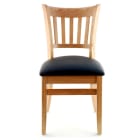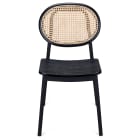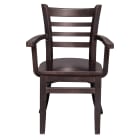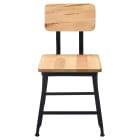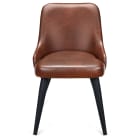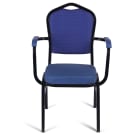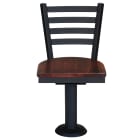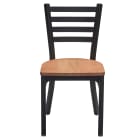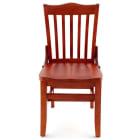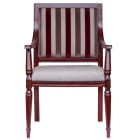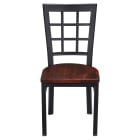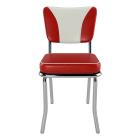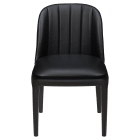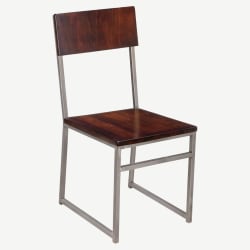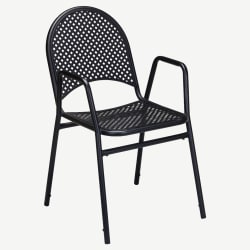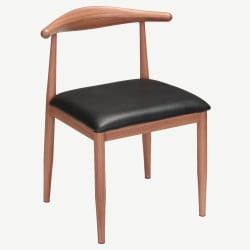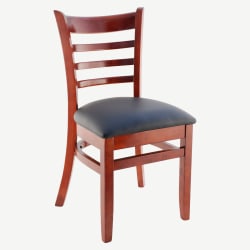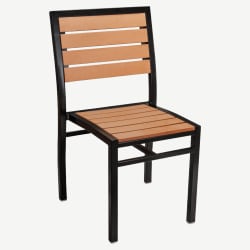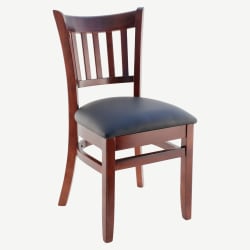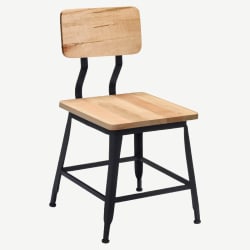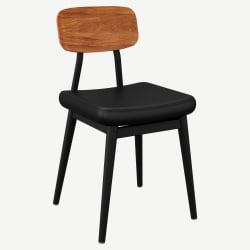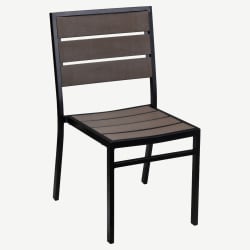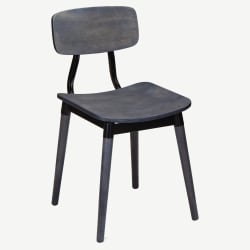Restaurant Chairs
Popular Products
Restaurant Chairs Buying Tips
For as long as there have been hungry people, there has been an enterprising person willing to charge them for food. The ancient Romans had walkup fast food stalls, and those were the mainstays until a genius in Paris made the first restaurant. They combined eating and ambience to create an experience. For the first time someone could sit down and have a meal in a place that wasn’t a tavern.
Yes, a tavern is a wonderful place to gather with friends, but a bit lacking for an evening out with the family. And a quiet evening on a date? Unfinished plank benches and tavern songs are not known to be conducive for romance. Restaurants are not just for consuming food. They are for creating an experience.
In creating an experience, we must have the proper setting. And key to the setting is your choice of tables and chairs. The right or wrong seating and tables can make or break an experience, turning even the most well thought out and delicious meal into something forgettable. Which is something we never want no matter what type dish we serve. Our venues live on the memories that our customers make in them.
Unfortunately, the tables and chairs that we use at home could never last in a popular venue. Unlike the dainty house chairs, restaurant chairs have to be tough enough to withstand the constant traffic. With stronger frames, and stain resistant materials that can take the abuse. And maintain a balance of comfortable enough to enjoy the meal, not so comfortable that they move in. We want customers to feel like family, not to actually become family.
The chairs and tables we use in restaurants cost a bit more than household furniture. But that has to be, because strength and durability cost more to produce. Wicker and pressboard could never stand up to the strain of hundreds of customers throughout the day. Much less thousands of people over the years.
Commercial versus Residential Chairs
What is the difference between chairs for restaurants and chairs made for residential use? Should it even matter at all? Can you use domestic chairs for commercial settings and vise versa?
The key differences between a domestic chair and a restaurant chair are the materials and the manufacturing process. A restaurant chair is built for sturdiness and with versatility to suit even the busiest commercial environments. Because most venues draw in a lot of high foot traffic, it’s important for the seating to stand against the constant wears and tears as well as hold different body weights. Like with most commercial furniture, the goal of a restaurant chair is to be replaced every 10 years and be fluid enough to adapt to different trends. While commercial grade chairs are more expensive, the cost of having to fix and replace broken parts or buy a new set of chairs in less than two years can be heftier.
Residential chairs, on the other hand, aren’t created with as sturdy materials while using flashier designs to follow the most updated furniture trends. They have a much shorter lifespan than chairs for restaurants. The pricing is also a lot lower and they don’t typically have to adhere to any specific coding. While quality is important to many buyers, it’s not as prioritized as furniture exclusively designed for commercial environments. Because the residential sector is generally private, concerns for mishandling of chairs due to large groups are a lot less.
Take Notice of the Available Space
It’s important to know what the dimensions of seating you need and how many chairs can you fit in your space. Arm chairs are not recommended for small spaces. You don’t want your large space to look too empty either by only filling it with a couple of café chairs either. There are legal requirements related to seating as well. For example, areas for emergency exists should be clear.
As a rule of thumb, you should reserve around 30 – 35 square feet per seat to ensure that your guests are comfortable and that your restaurant doesn’t become overcrowded when you are at full capacity.
Calculations can shift a bit depending on what seating experience you are providing your guests with. For a full service, you should leave 12 – 15 square feet. Dining that is slow and provides intimacy and privacy may only require 14 – 20 square feet per person. Aisles should at least measure 18” wide, if not wider, especially if waiters are carrying a lot of dishes.
Choosing the Best Restaurant Chairs
One size does not fit all when it comes to your restaurant. You don’t have to compromise. There are hundreds of styles and colors to choose from. From solid wood to steel, and so many combinations of the two. Along with seats and backs that can be made with different finishes and patterns or upholstered in a variety of vinyls and fabrics. And that's just the chairs, you can find tables with resin tops or stained wood.
The styles and combinations are endless. With so many varieties of restaurant tables and chairs you can find the ones that are perfect for your venue, you have an industrial/rustic pizza and sushi fusion cafe? We make a setting that would fit your style.
Different venues have different needs. Stately wooden ladder-backs for an ethnic restaurant, or metal stools might complement your industrial bar. Maybe something completely different, depending on your vision. It's your vision of your restaurant that matters. Take the chance and make that vision a reality.
Frequently Asked Questions
What is the Average Seat Height of Restaurant Chairs?
The standard restaurant chair has a floor to seat height of 17 to 20 inches. This seat height allows guests to sit comfortably at a standard 30” height restaurant table.
How many Chairs I Need for my Restaurant?
It depends on the size of your dining room. A small restaurant will typically have between 8 to 15 tables that can seat 2 to 8 people at a time.
A medium sized restaurant can fit 20 to 35 tables which can accommodate around 6 to 10 people.
A good way of going about it is analyzing and calculating your seating capacity but you need to already have a floor layout plan for that.
But the actual number of seats that you can fit comfortably in your dining area depends on a few different variables. For example, if you plan on making use of booth seating, you may be able to squeeze in a few chairs. However, if you are using bulky furniture or want to make your aisles wide enough for wheelchairs or table side service, you will need to reduce the number of chairs you initially planned on using.
Are Restaurant Chairs Comfortable?
One of the most common complaints customers have is uncomfortable seating. Many restaurant owners get caught up in their budget which leads them to selecting chairs that are somewhat uncomfortable.
This is why it’s important to keep customers in mind when furnishing your restaurant. Having a theme is important for a good restaurant design. If you know what to look for and where, you can find chairs that are both stylish and comfortable.
If your layout and service is designed in such a way that encourages extended seating time among patrons, fully padded chairs with curved/elongated backrests and arm rests are recommended.

